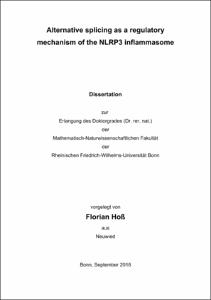Hoß, Florian: Alternative splicing as a regulatory mechanism of the NLRP3 inflammasome. - Bonn, 2019. - Dissertation, Rheinische Friedrich-Wilhelms-Universität Bonn.
Online-Ausgabe in bonndoc: https://nbn-resolving.org/urn:nbn:de:hbz:5n-55805
Online-Ausgabe in bonndoc: https://nbn-resolving.org/urn:nbn:de:hbz:5n-55805
@phdthesis{handle:20.500.11811/8074,
urn: https://nbn-resolving.org/urn:nbn:de:hbz:5n-55805,
author = {{Florian Hoß}},
title = {Alternative splicing as a regulatory mechanism of the NLRP3 inflammasome},
school = {Rheinische Friedrich-Wilhelms-Universität Bonn},
year = 2019,
month = oct,
note = {The innate immune system relies on germ-line encoded pattern recognition receptors and is critically involved in the early sensing of pathogens and disturbances of cell homeostasis. Upon activation by pathogenic or sterile danger signals, several cytosolic receptors of the innate immune system (e.g. NLRP3) can recruit multi- protein signaling platforms, so called inflammasomes. Inflammasome formation leads to the activation of caspase-1, causing pyroptosis as well as maturation and release of IL-1β and IL-18. NLRP3 is critically involved in several cardiovascular, neurodegenerative and inflammatory diseases.
This study aimed to decipher whether alternative splicing (AS) might act as a regulator of NLRP3 inflammasome activation, similarly to what is described for other vertebrate immune receptors and plant R-proteins. I could show that the LRR of NLRP3 is encoded by multiple repetitive and highly conserved exons, a feature which is shared by other LRR encoding genes. This strict exonic modularity of LRR domains of several human gene families serves as a prerequisite for non-destructive AS. Indeed, I could show AS of the LRR of several NOD-like receptors, most prominently in NLRP3. Human NLRP3, but not mouse NLRP3, could be detected as two major isoforms: The fully active NLRP3 full-length variant and a variant lacking exon 5. By use of several different model systems and readouts, NLRP3 ∆ exon 5 could be shown to be inert to common NLRP3 activators. Furthermore, I could show that alternative splicing is stochastically regulated on a single-cell level. Mechanistically, I could provide evidence that NLRP3 ∆ exon 5 is inactive due to the absence of a necessary interaction surface for NEK7 binding, required for NLRP3 activation. Surprisingly, a prolonged priming for over 10 h rendered NLRP3 ∆ exon 5 activatable. In combination with the stochastic isoform expression, this allows for a backup pool of cells, which do not become pyroptotic in the first round of NLRP3 inflammasome activation, but rather enable a sustained inflammatory response.
The data presented here provide evidence for a not yet described regulatory role of AS in NLRP3 inflammasome activation through differential utilization of highly conserved LRR modules. Moreover, the species differences described here might hold therapeutic potential that could not have been revealed in mouse models.},
url = {https://hdl.handle.net/20.500.11811/8074}
}
urn: https://nbn-resolving.org/urn:nbn:de:hbz:5n-55805,
author = {{Florian Hoß}},
title = {Alternative splicing as a regulatory mechanism of the NLRP3 inflammasome},
school = {Rheinische Friedrich-Wilhelms-Universität Bonn},
year = 2019,
month = oct,
note = {The innate immune system relies on germ-line encoded pattern recognition receptors and is critically involved in the early sensing of pathogens and disturbances of cell homeostasis. Upon activation by pathogenic or sterile danger signals, several cytosolic receptors of the innate immune system (e.g. NLRP3) can recruit multi- protein signaling platforms, so called inflammasomes. Inflammasome formation leads to the activation of caspase-1, causing pyroptosis as well as maturation and release of IL-1β and IL-18. NLRP3 is critically involved in several cardiovascular, neurodegenerative and inflammatory diseases.
This study aimed to decipher whether alternative splicing (AS) might act as a regulator of NLRP3 inflammasome activation, similarly to what is described for other vertebrate immune receptors and plant R-proteins. I could show that the LRR of NLRP3 is encoded by multiple repetitive and highly conserved exons, a feature which is shared by other LRR encoding genes. This strict exonic modularity of LRR domains of several human gene families serves as a prerequisite for non-destructive AS. Indeed, I could show AS of the LRR of several NOD-like receptors, most prominently in NLRP3. Human NLRP3, but not mouse NLRP3, could be detected as two major isoforms: The fully active NLRP3 full-length variant and a variant lacking exon 5. By use of several different model systems and readouts, NLRP3 ∆ exon 5 could be shown to be inert to common NLRP3 activators. Furthermore, I could show that alternative splicing is stochastically regulated on a single-cell level. Mechanistically, I could provide evidence that NLRP3 ∆ exon 5 is inactive due to the absence of a necessary interaction surface for NEK7 binding, required for NLRP3 activation. Surprisingly, a prolonged priming for over 10 h rendered NLRP3 ∆ exon 5 activatable. In combination with the stochastic isoform expression, this allows for a backup pool of cells, which do not become pyroptotic in the first round of NLRP3 inflammasome activation, but rather enable a sustained inflammatory response.
The data presented here provide evidence for a not yet described regulatory role of AS in NLRP3 inflammasome activation through differential utilization of highly conserved LRR modules. Moreover, the species differences described here might hold therapeutic potential that could not have been revealed in mouse models.},
url = {https://hdl.handle.net/20.500.11811/8074}
}






